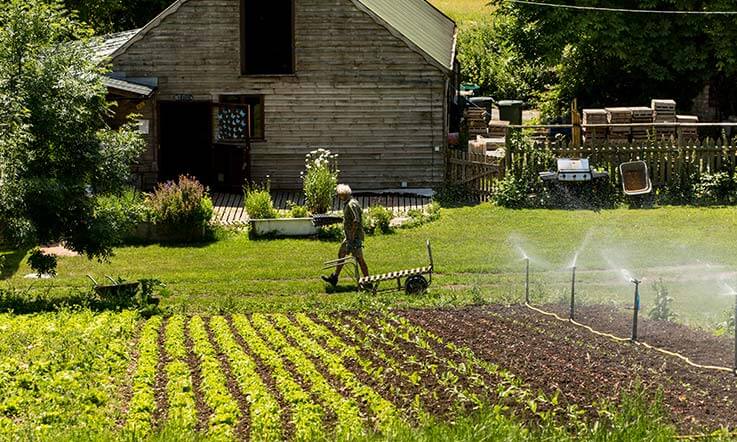ORC’s Senior Livestock Researcher Lindsay Whistance reviews this FiBL technical guide which describes the natural relationship between the cow and her calf and draws conclusions for the species-appropriate rearing of calves. From the variety of possible systems of mother-bonded and fostered calf rearing, 11 selected methods are presented with practical examples.
Dairy farming systems typically separate cows from calves for a range of purposes including rationalising daily management routines, regulating feeding of both cow and calf, and for biosecurity purposes, such as limiting the transfer of Johne’s disease from cow to calf. There is nevertheless an increase in interest from farmers wishing to keep cows and calves together thus enabling them to show natural behaviour patterns such as suckling and maternal care, to develop bonds between generations and to promote generational learning. Depending on how they are set up, calf at foot and nurse cow systems, can promote some or all of these behaviours but they require changes in farmer behaviour and a change in how the housing system is used or modified to accommodate cows and calves now sharing space.
This 35-page technical guide for dam/nurse cow rearing of calves has been published by the Research Institute of Organic Agriculture (FiBL) in Switzerland. The content is divided by themes of natural behaviour, rearing systems, benefits and challenges, legal elements and housing design and ends with a generous number of case studies (11 in total) illustrating how different systems operate in three countries, including UK. The text is broken up with headings, tables and colour changes which benefits the reading experience and promotes easy finding of specific information at later readings. The illustrations and photographs are simply but well presented and support the content and understanding of different aspects of rearing calves with cows. There are also occasional links to supporting material, some of which are available in English.
The guide, very usefully, begins with a description of what is natural behaviour, drawing heavily on important observational work on the first year of an animal’s life, carried out by Reinhardt in 1970s-80s, and then adds context for how to adapt/achieve different aspects in modern systems. For example, if nurse cows are to be used, the guide recommends that ‘foreign calves are best accepted by the cow when its own calf is sucking simultaneously’ and that up to eight weeks old, ‘calves should be given the opportunity to suckle several times a day for about 50 minutes in total’.
Explanations are included of some central terminology and descriptions of the different combinations of cow-calf access including staying with the dam until weaning, a transition from dam to nurse cow, or only access to a nurse cow. Continuous and restricted access systems and different weaning approaches to manage cow and calf stress are also covered. As with other rearing systems, there are clear benefits and challenges, for cows, calves and humans, and those stated here are a combination of farmer feedback and scientific studies. Importantly, the guide addresses the difficult moral issue of rearing or selling male calves and offers some partial solutions.
Although the page addressing legal requirements (or a lack thereof) specifically covers only Switzerland, Germany and Austria, much of the content is applicable elsewhere and all farmers will be aware of the standards and legislation pertinent to their own country and certification requirements. Two pages of the guide cover housing design considering the welfare of cow and calf during suckling and weaning and touches upon animal ‘flow’ easing movement and handling of animals during, e.g., milking and feeding times. Only the short section on tethered systems is not applicable, or appropriate, for UK farmers.
Of the 35 pages in the guide, 22 of them are dedicated to descriptions of 11 case study farms where varying combinations of dam-rearing and nurse-cow rearing are practised. These case studies are from Switzerland, Germany and England and herd sizes range from 20 – 60 cows illustrating that cow-calf systems are currently practised at both micro-dairy and smaller herd levels (though let’s remember that as recently as 1996, the average herd size in UK was 75 cows: https://ahdb.org.uk/dairy/uk-and-eu-cow-numbers). Though not touched upon here, research carried out by Louis Bolk Institute in the Netherlands (2000-2006) showed that cow with calf systems can also work in more ‘conventional’ housing (cubicles and slatted floors) and with herd sizes of up to 120 cows (https://www.louisbolk.nl/en/publications).
In these case studies, alongside a description of housing design and animal management, room is made to include animal health elements and key farmer observations. Typical key points made are the need for animal handlers to be patient, observant and flexible. They also serve to demonstrate that systems and solutions to challenges can quite varied being farm – and farmer – specific.
Bearing in mind that this is a translated piece of work, on the whole, the language used is clear and succinct. In one or two places the system descriptions are less clear and require more than one reading to understand. There are also minor spelling errors (e.g., ‘through’ for ‘trough’) and atypical terminology (‘cow calf’ for ‘heifer calf’) though these are easily interpreted. The stated need for ‘double fencing’ on page 13, I suspect, refers to two-stranded electric fencing rather than parallel fences, unless Flekvieh or Brown Swiss calves are regular little Houdinis!
This guide is informative and well worth reading and the publication is available for free download at shop.fibl.org : https://www.fibl.org/en/shop-en/1660-mother-bonded-calf-rearing
